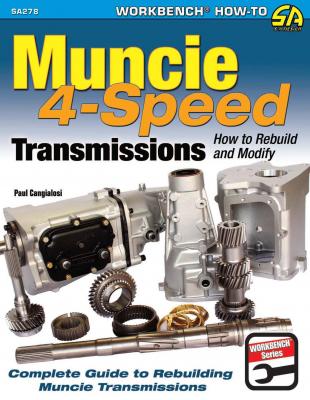Muncie 4-Speed Transmissions. Paul Cangialosi
Читать онлайн.| Название | Muncie 4-Speed Transmissions |
|---|---|
| Автор произведения | Paul Cangialosi |
| Жанр | Сделай Сам |
| Серия | |
| Издательство | Сделай Сам |
| Год выпуска | 0 |
| isbn | 9781613252116 |
The step-by-step photo procedures also contain many additional photos that show how to install high-performance components, modify stock components for special applications, or even call attention to assembly steps that are critical to proper operation or safety. These are labeled with unique icons. These symbols represent an idea, and photos marked with the icons contain important, specialized information.
Here are some of the icons found in Workbench® books:
Important!—
Calls special attention to a step or procedure, so that the procedure is correctly performed. This prevents damage to a vehicle, system, or component.
Save Money—
Illustrates a method or alternate method of performing a rebuild step that will save money but still give acceptable results.
Torque Fasteners—
Illustrates a fastener that must be properly tightened with a torque wrench at this point in the rebuild. The torque specs are usually provided in the step.
Special Tool—
Illustrates the use of a special tool that may be required or can make the job easier (caption with photo explains further).
Performance Tip—
Indicates a procedure or modification that can improve performance. Step most often applies to high-performance or racing engines.
Critical Inspection—
Indicates that a component must be inspected to ensure proper operation of the engine.
Precision Measurement—
Illustrates a precision measurement or adjustment that is required at this point in the rebuild.
Professional Mechanic Tip—
Illustrates a step in the rebuild that non-professionals may not know. It may illustrate a shortcut, or a trick to improve reliability, prevent component damage, etc.
Documentation Required—
Illustrates a point in the rebuild where the reader should write down a particular measurement, size, part number, etc. for later reference or photograph a part, area or system of the vehicle for future reference.
Tech Tip—
Tech Tips provide brief coverage of important subject matter that doesn’t naturally fall into the text or step-by-step procedures of a chapter. Tech Tips contain valuable hints, important info, or outstanding products that professionals have discovered after years of work. These will add to your understanding of the process, and help you get the most power, economy, and reliability from your engine.
This is a classic Muncie bolt pattern and case. It’s a standard M20 model.
To understand the evolution of the Muncie 4-speed you have to look at a series of engineering platforms that led to the final design of this transmission. The Muncie design has roots going back to 1935. I took the time to research the patent number that is cast into most Muncie main cases. It is U.S. Patent Number 3,088,336 (see Appendix). You will see that James W. Fodrea designed the patent; no other engineers are listed. If you look closely, you’ll see that the patent drawings look nothing like the Muncie 4-speed but rather like the BorgWarner T10! Therefore, the Muncie patent is basically a design for the layout of a 4-speed transmission. This “layout” is a 4-speed transmission with four forward gear ratios in the main case, a midplate bearing support, and a reverse gearset in the extension housing.
BorgWarner was a company founded in 1928 from the merger of Borg and Beck (founded in 1904) and Warner Gear (founded in 1901). They designed a 3-speed transmission, the T85, which was originally used in the 1935 Chrysler Airflow. It was used right up to 1971 in the Ford Pickup F100 with an overdrive. The T10 shares the same case design, gear centers, and 3-4 synchronizer as the T85. The cases have a distinctive similar size, shape, and cover-bolt pattern.
If you look at Fodrea’s 4-speed patent drawings you can clearly see it was based on the T85 platform. His brilliant and well-thought-out idea was to make it into a 4-speed. It’s important to understand that in 1956 General Motors didn’t have the money for the Corvette program. Zora Arkus-Duntov wanted to use the design of General Motors’ employee James Fodrea. BorgWarner was probably the foremost manual transmission manufacturer at the time, and basically wrote the book on manual transmission design. (They are credited with hundreds of manual transmission patents.) It is therefore no surprise that a decision was made for BorgWarner to manufacture this 4-speed transmission based on the GM concept drawings and Fodrea’s patent. It was a very logical decision: Tooling costs would be minimal because hobs, castings, and certain components could be used from the T85 platform. This would be the fastest and most cost-effective way to put a 4-speed into a Corvette with very little risk. Many Corvette restoration books share the common misconception that the 4-speed T10 and Muncie are two separate entities. They are not; the Muncie evolved from the T10.
James Fodrea and Alice Henman are on the way to visit the Muncie plant in 1957. Fodrea was the GM engineer whose name is listed on the design patent for the Muncie. Although he is seen with a 1957 Corvette, which came with a T10 4-speed, the design of the T10 and Muncie share the same features.
This is how the Muncie countergear’s design evolved.
